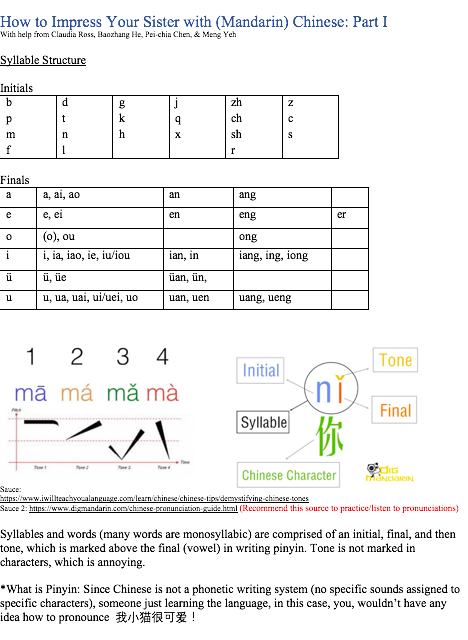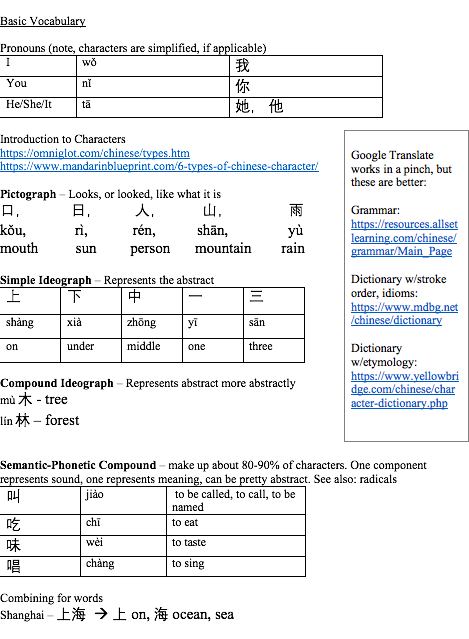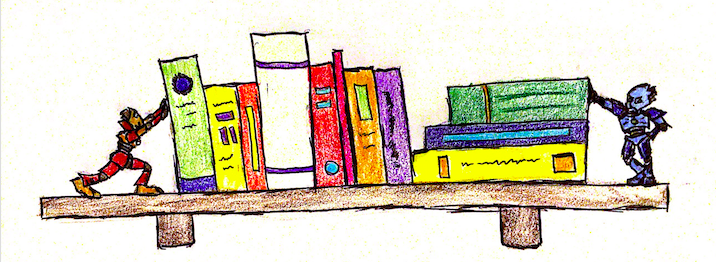I absolutely love the rich history of the language and the culture, and it's personally significant as part of my heritage. It's not my first language, but it was my major in university. However, being out of school for almost 3 years now, I've been out of practice. There's no one in my area who speaks the language, sadly but understandably. So when a coworker recently asked me to help him learn a bit of Chinese because his older sister spent time working as a linguist out of Taiwan, I was pretty stoked. Here are some of the worksheets/lessons I whipped up for him, and I figured they'd be cool to share, in case any of you guys wanted an informal introduction to the language.
The worksheets were made in microsoft word and I did my best to informally cite the screenshots on the same page. I'll also try and explain in typing what I explained to my coworker during breaks during our 'lesson time', although some of the typed explanation may be redundant redundant to the worksheets.
 Page 1, worksheet 1
Page 1, worksheet 1
Characters: 你好
Pinyin: Nǐ hǎo!
English: Hello!
Pinyin system was actually developed to raise literacy rates among the Chinese people, not for foreigners to learn Chinese easier, although it definitely helps with that. It uses the latin alphabet and tone marks to represent the pronunciation of their corresponding characters.
As you can probably tell, there's not a huge combination of syllables available with the above listed consonants and vowels (initials and finals). Even if you add in tonal variations, there's still a very limited number of syllable combinations available, which is why the richness of etymology is found in the characters themselves, not necessarily their phonological counterparts (the pronunciation). But more on that later.
Tones. Four tones in Mandarin, more in Cantonese, although people tell my different answers when I ask exactly how many are in Cantonese. But both (all) Chinese dialects use the same writing system of characters. (however, some places use traditional characters, and other places use simplified characters, but that's another topic). Tones were and still are one of the most challenging aspects of the Chinese language for me to really 'get'. It's not something a lot of native English speakers have a trained ear for, and, quite frankly, many don't see the importance of getting the tones right (myself included, on my grumpy days). Luckily, with the aforementioned low combination of syllables in the language, Chinese is a highly contextual language, and so the odds are, if you mess up your tones, people will have a general idea what you're talking about. But that doesn't mean you shouldn't try to speak correctly.
Example: A fellow Chinese major, a few years ahead of me, told us a story from his own time studying abroad in China. Their assignment for the weekend was to go do something, and tell the class about it the following Monday using new vocabulary or whatever. Pretty standard assignment. My classmate said, "I went to go see the pandas!" But he pronounced it wrong.
熊猫 xióngmāo, panda, literally the characters for 'bear' and 'cat'.
What he said was:
胸 毛 xiōng máo, which means 'chest hair'.
Consider yourselves tonally warned ![]()
Notes on the pronunciation of consonants, as not all of them are the same in English as they are in Mandarin/Chinese. (If I mention 'Chinese', I'm talking about Mandarin Chinese, and all characters are simplified, as opposed to traditional).
q - this is like a blend between 'ts' and 'ch'.
x- this consonant is pronounced almost like an 's', but your tongue is constricting the airflow against the back of your upper teeth, as opposed to that little ridge where the roof of your mouth and your upper teeth meet (called the alveolar ridge). Kind of like a snake hissing, but shorter and a bit more forceful.
r- the tip of the tongue is curled back and up toward the roof of the moth - more retroflexed - than an (American) English 'r'. If listeners and/or enunciators aren't careful, it can sound like 'l'.
c - the most common way I hear this sound explained to native English speakers. Say the word "cats". Then say "-ats". Then just say "- - ts", and that's the sound.
For the vowels, also called finals, since they form the final part of a syllable, throw out English rules about combining vowel sounds. If you grew up with 'when two vowels go walking, the first one does the talking', that doesn't apply to Pinyin. Vowels are annoying in pretty much every language, as far as I know, so if you have more questions about them here, I'm not the person to ask XD
 Page 2, worksheet 1
Page 2, worksheet 1
我 - wǒ - this is the character for the first person singular. I, me, my, so on. A language professor from my semester abroad in Shanghai explained that the pronoun's roots mean essentially 'the part of we that is not king'. I'm not sure how figurative that is, but it really highlights the deep roots of collectivism in the culture. More literally, the character is comprised of two radicals (the components of a character that can be broken down, similar but not the same as how we have morphemes, small units of meaning in our language. example: cats is two morphemes. "cat", the feline, and "-s" suffix, the plural indicator). The radicals in 我 are 手 shǒu, which is a hand, and 戈 gē, which is dagger or axe or tool. A hand holding a tool, or a laborer. And the emperor had his own formal pronoun that only he was allowed to use, back in the day, and he also doesn't have to work the fields or anything, so everyone else who did had to develop their own way to refer to themselves, as well.
Under the pictographs section, you can probably see the connections between the characters and their meanings, which is essentially the meaning of the term 'pictograph'. If you wanna see really cool stuff, you can look into the ancient oracle bone script.
Simple ideographs are fun and I also find them humorous.
凹 āo by itself means concave.
凸 tū by itself means convex. Isn't it great??
Now, compound these simple ideographs and you get 凹凸 āotū, which means 'bumpy'.
Chinese is full of these compounds, some pretty close to literal, like above, and some requiring a bit more abstraction. Probably more on those later.
Lastly, a note on the semantic-phonetic compounds.
Semantics, for those wondering, is kind of like the meaning(s) behind the words (semantics is the difference between your big sister and your large sister), and phonetics is the actual sounds made by the vocal tract.
So take a look at the characters listed under the semantic-phonetic section.
叫,吃,味,唱
You see what they have in common? The radical they have in common? It's that little box on the left of each character, which is the 口 kǒu radical. If you remember from the pictograph section, 口 kǒu is 'mouth'. You can see the semantic meaning the 'mouth' radical adds to the words for 'to be named/called', 'to eat', 'to taste', and 'to sing'.
Anyways, that's it for part 1. I'll try and post/adapt more of these as I develop them and find the time! Also a disclaimer, the lessons don't really follow any pedagogy or methodology for developing Chinese fluency, but more like what I thought were relevant factoids and stuff I find fascinating at every level of learning the language that I think I can explain to a person who knows little or nothing about it without overwhelming them.
-
 1
1



0 Comments
Recommended Comments
There are no comments to display.